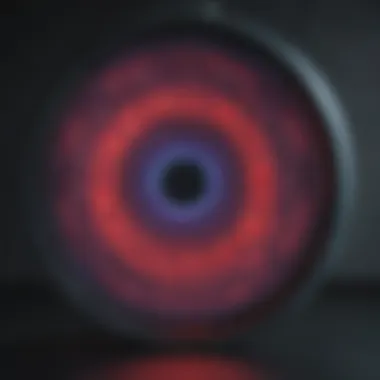Exploring PSMA PET Imaging: Mechanism and Impact


Overview of Research Topic
Brief Background and Context
Prostate cancer remains one of the most prevalent malignancies affecting men globally. The challenges in accurately diagnosing and tracking this disease underscore the need for advanced imaging techniques. Prostate-specific membrane antigen (PSMA) positron emission tomography (PET) emerges as a pivotal tool in this regard. By focusing on PSMA, a protein often overexpressed in prostate cancer cells, this imaging modality allows for enhanced visualization of tumors, helping clinicians make informed decisions regarding diagnosis and treatment.
Importance in Current Scientific Landscape
In recent years, PSMA PET has garnered significant attention in the field of oncology. Traditional imaging modalities, such as computed tomography (CT) and bone scans, exhibit limitations in specificity and sensitivity. PSMA PET addresses these shortcomings by providing a novel approach to detect prostate cancer at earlier stages and precision in monitoring treatment efficacy. In an era where personalized medicine is becoming paramount, understanding the mechanisms and applications of PSMA PET is critical for healthcare professionals and researchers alike.
Methodology
Research Design and Approach
This article synthesizes existing literature on PSMA PET imaging, utilizing a systematic review approach. Data from peer-reviewed journals, clinical studies, and imaging guidelines were analyzed to present a cohesive overview. Additionally, insights from expert opinions in the field were integrated to capture the evolving landscape of PSMA PET.
Data Collection Techniques
Key databases such as PubMed, Scopus, and relevant medical websites were used to collate comprehensive data. The search terms included "PSMA PET," "prostate cancer imaging," and "treatment monitoring." Inclusion criteria focused on articles published in the last decade to ensure up-to-date information. This methodological framework enables a rigorous examination of PSMA PET's role in contemporary prostate cancer management.
"PSMA PET has transformed our approach to prostate cancer, providing clarity where ambiguity once existed."
This structured approach highlights the significance and versatility of PSMA PET imaging, laying the groundwork for a deeper exploration of its mechanisms and applications in subsequent sections.
Prelims to PSMA PET Imaging
Positron emission tomography (PET) using prostate-specific membrane antigen (PSMA) has transformed the landscape of prostate cancer diagnostics. Prostate cancer often presents complex challenges in detection and management. Traditional imaging techniques sometimes fall short in sensitivity and specificity for detecting localized disease or metastases. This is where PSMA PET imaging shows its true potential. This section will explore the fundamentals of PSMA, its importance, and its developmental history.
Definition of PSMA
Prostate-specific membrane antigen (PSMA) is a protein predominantly found on the surface of prostate cancer cells. It plays a crucial role in cancer progression and is of significant interest for targeted imaging and therapy. PSMA's expression is markedly elevated in malignancy compared to normal prostate tissue, making it an attractive target for diagnostic imaging. This specificity allows for finer detection of disease, particularly in patients with advanced stages of prostate cancer. Understanding PSMA is vital for harnessing its full diagnostic capabilities.
Development History of PSMA PET
The development of PSMA PET imaging has its roots in the increasing need for effective diagnostic tools in oncology. The initial identification of PSMA occurred in the 1990s, related to its role in prostate cancer biology. Researchers soon recognized its potential as a biomarker. With advances in radiolabeling techniques, radiopharmaceuticals that could bind to PSMA were developed.
One of the first tracers, 68Ga-PSMA-HBED-CC, was introduced in the early 2010s, providing a significant leap in imaging technology. This was followed by a greater understanding of the radiochemistry and improved imaging protocols, leading to broader clinical adoption. Over the years, clinical trials have validated PSMA PET's effectiveness in various scenarios, confirming its utility in the detection of recurrent disease and aiding in treatment planning. PSMA PET imaging has matured into a value-driven methodology that influences management decisions and patient outcomes.
Mechanism of PSMA PET
The mechanism of PSMA PET involves understanding both the biochemical properties of Prostate-Specific Membrane Antigen (PSMA) and how these properties facilitate imaging. PSMA is a protein expressed on the surface of prostate cancer cells, playing a crucial role in the diagnosis and management of prostate cancer. It is pivotal that the mechanisms behind PSMA PET are explored to comprehend its clinical significance fully.
Biochemistry of PSMA
PSMA is a type II membrane protein that is primarily found in prostatic tissue. The normal levels of PSMA are low in healthy prostate cells, but these levels increase significantly in malignant cells. The binding of ligands to PSMA is an important aspect that enables targeted imaging.
The active site of PSMA has unique characteristics that can be exploited for imaging. It is a carboxypeptidase, meaning it plays a role in breaking down peptides. This enzymatic activity is now understood to enhance the accumulation of radiotracers.


- PSMA has a unique structure allowing for selective binding.
- Its overexpression in prostate cancer cells makes it a valuable target.
- The biochemical interactions that occur during radiotracer binding are critical for enhancing imaging precision.
Understanding the biochemistry of PSMA not only sheds light on how these interactions occur but also emphasizes the importance of targeted approaches when diagnosing prostate cancer.
The Role of Radiotracers
Radiotracers are compounds that emit positrons and are crucial for PSMA PET imaging. They are designed to bind specifically to PSMA, enabling visualization of prostate cancer cells. The radiotracers such as gallium-68 PSMA-11 or florbetapir F18 can help deliver precise imaging.
The effectiveness of radiotracers is measured in terms of their pharmacokinetics, which dictate how the compound behaves in the body. Following injection, the radiotracer circulates and binds to PSMA. This process allows for the identification of cancer sites during PET scans.
- Effective radiotracers must demonstrate high specificity to minimize false positives.
- The binding affinity must be optimized to enhance tumor visibility.
The advancement of radiotracers continues to be an area of research, focusing on improving binding efficiency and reducing exposure to radiation for patients.
Imaging Process Overview
The imaging process of PSMA PET involves several key steps. After the radiotracer is administered, time is allocated for the compound to distribute through the body. Generally, about one hour is sufficient for this process. The patient is then placed inside a PET scanner.
The scanner detects the emitted positrons from the radiotracers. The resulting data are processed to create images, reflecting where the radiotracer has bound to PSMA.
- The resolution and sensitivity of the PET scanner play significant roles in image quality.
- Image interpretation requires a skilled radiologist to differentiate between benign and malignant tissues.
The correlation between the imaging results and clinical outcomes emphasizes the real-world applications of PSMA PET imaging. As technology advances, the imaging process will become more efficient, improving diagnosis and treatment planning.
Clinical Applications of PSMA PET
The clinical applications of PSMA PET imaging are multi-faceted and essential in the management of prostate cancer. This advanced imaging technique greatly improves the accuracy and effectiveness of both diagnosis and treatment planning. The relevance of PSMA PET lies in its ability to identify prostate-specific membrane antigens, which are present in high concentrations in prostate cancer cells. This specificity enhances the diagnostic capability, providing clearer insights into the disease's extent and progression.
Diagnosis of Prostate Cancer
PSMA PET imaging plays a critical role in the diagnosis of prostate cancer. It offers a non-invasive alternative to traditional biopsy methods that can be stressful for patients. Through the use of radiotracers that bind to PSMA, clinicians can visualize the presence of malignancies with high precision. Studies have shown that PSMA PET is more sensitive than conventional imaging techniques like CT or MRI in detecting prostate cancer, especially in cases of biochemical recurrence. This increased sensitivity significantly aids in making more accurate diagnoses, which ultimately leads to better clinical outcomes.
Staging and Re-staging
Staging is a vital step in prostate cancer management. Proper staging defines the treatment strategy and the expected prognosis. PSMA PET provides valuable information that helps in assessing how far the cancer has spread. It is particularly useful for identifying lymph node metastasis and distant metastases that may be overlooked by other modalities. For patients undergoing treatment, re-staging is equally important. The ability of PSMA PET to detect changes in the disease after therapy allows clinicians to adjust treatment plans promptly, ensuring that patients receive the most effective interventions.
Assessment of Treatment Response
Evaluating the response to therapy is crucial in managing prostate cancer effectively. PSMA PET imaging allows clinicians to monitor how well a treatment is working by visualizing changes in PSMA expression. Radiographic changes that signify tumor response can be detected earlier compared to traditional methods. This early assessment can facilitate timely modifications to treatment regimens, which can improve patient outcomes.
"PSMA PET shines as a leading-edge tool in the precision medicine landscape, playing a pivotal role in both diagnosing and managing prostate cancer."
In summary, the clinical applications of PSMA PET are indispensable in the realm of prostate cancer. From initial diagnosis to treatment response assessment, the technique enhances the ability to provide personalized and effective care.
Contrast with Other Imaging Techniques
In the rapidly evolving field of medical imaging, differentiating between various modalities is crucial. PSMA PET imaging offers a unique perspective in the diagnosis and treatment of prostate cancer. Its effectiveness and specificity must be compared to other imaging techniques such as MRI and CT scans. Understanding these comparisons can provide insight into the optimal use of PSMA PET in clinical settings.


Comparison to MRI
Magnetic Resonance Imaging (MRI) is widely used in the imaging of soft tissues, including the prostate. One significant advantage of MRI is its high-resolution imaging capability and excellent contrast provided in soft tissue differentiation. It does not involve ionizing radiation, making it a safer option for periodic monitoring.
However, MRI has some limitations in prostate cancer detection. It may miss smaller lesions or those that are less aggressive. When comparing MRI to PSMA PET, the latter demonstrates superior sensitivity in identifying metastatic disease. This heightened detection capability is particularly relevant in patients with biochemical recurrence, where MRI might not reveal the full extent of disease presence.
Furthermore, the specificity of PSMA PET arises from targeting the prostate-specific membrane antigen, which MRI does not do. Therefore, while MRI is a powerful tool, it does not provide the same level of detail in cancer staging and treatment planning as PSMA PET imaging.
Comparison to CT Scans
Computed Tomography (CT) scans are another commonly used imaging modality. They are particularly useful in assessing bone involvement and larger metastases. A major benefit of CT is its speed and accessibility, especially in emergency situations. It delivers quick imaging results, which can be beneficial for immediate clinical decisions. However, CT does involve exposure to ionizing radiation and generally provides lower soft tissue contrast than MRI.
When evaluating CT in contrast to PSMA PET, one notable difference is in the detection of small lymph node metastases. CT tends to have lower sensitivity for these smaller lesions, while PSMA PET can identify them more effectively due to its targeted approach. The radiotracer used in PSMA PET specifically binds to cancer cells, resulting in more accurate imaging.
PSMA PET imaging provides a distinct advantage by offering better localization of prostate cancer, particularly in complex cases where traditional imaging struggles.
In summary, while MRI and CT scans provide valuable information, PSMA PET imaging stands out in the precise detection and characterization of prostate cancer. Its ability to highlight specific cancerous tissue allows for more tailored treatment strategies. This differentiation not only helps in disease management but can also significantly improve patient outcomes.
Advantages of PSMA PET
In the landscape of imaging technologies for diagnosing prostate cancer, PSMA PET offers distinct advantages that elevate its significance. The intricate connection between prostate-specific membrane antigen and the imaging capabilities of PET translates to enhanced accuracy and effectiveness. This section elucidates two primary advantages: higher sensitivity and specificity, along with the ability for early detection of metastasis. Each of these advantages plays a pivotal role in improving patient outcomes and guiding treatment decisions.
Higher Sensitivity and Specificity
One of the standout features of PSMA PET imaging is its heightened sensitivity and specificity for prostate cancer detection. Sensitivity refers to the test’s ability to correctly identify patients with the disease, while specificity denotes its capacity to correctly rule out those who do not have it.
Recent studies have shown that PSMA PET can detect prostate cancer lesions that other imaging techniques may miss. This is crucial because undetected cancer can lead to delayed treatment and worse prognosis. The specificity of PSMA PET is also noteworthy. By targeting the PSMA, which is overexpressed in prostate cancer cells, the imaging technique reduces the chances of false positives. This means that patients are less likely to undergo unnecessary invasive procedures or treatments.
"Higher accuracy in diagnosis not only streamlines patient management but also fosters trust in the imaging process."
Early Detection of Metastasis
The early detection of metastasis is another advantage of PSMA PET that cannot be overstated. Metastatic prostate cancer can severely affect treatment strategies and overall patient survival. Traditional imaging methods, like CT or MRI, may fail to identify small or early-stage metastasis.
PSMA PET enhances the ability to visualize metastatic sites more effectively. This capability is essential for tailoring treatment options. Early identification of metastasis allows oncologists to adjust therapies sooner rather than later, improving the chances of controlling the disease progression. Furthermore, with accurate staging, healthcare providers can offer personalized care plans, which can lead to better quality of life for patients.
Limitations of PSMA PET
PSMA PET is a noteworthy development in prostate cancer imaging, yet it is essential to acknowledge its limitations. Recognizing these drawbacks ensures proper integration into clinical practice and informs patients and medical professionals alike about its use and potential pitfalls.
Access and Availability
The accessibility of PSMA PET imaging can vary greatly across different regions and medical institutions. In some areas, the technology may not yet be available due to economic, infrastructural, or regulatory issues. This can lead to significant delays in diagnosis and treatment for patients who could benefit from timely imaging.
Furthermore, even in established medical centers, access might be limited by availability of radiotracers and trained personnel. Not all facilities have the capability to produce or administer these radiotracers, which adds another layer of limitation.
Patients seeking PSMA PET imaging must therefore consider the facilities near them. Traveling long distances for access may pose an additional burden on patients already dealing with the stresses of cancer treatment.


Cost Considerations
The financial aspect of PSMA PET imaging cannot be overlooked. This imaging modality is often more expensive than traditional methods like CT scans or MRI. The costs can arise from various components, including radiotracer production, the imaging procedure itself, and personal consultations often required post-imaging.
For many patients, insurance coverage can vary significantly. While some policies may cover the procedure, others may not, leaving patients responsible for out-of-pocket expenses. This financial burden can reduce the overall utility of this advanced imaging method, limiting it to those who can afford it.
In light of these concerns, it is crucial for healthcare providers to have transparent conversations with patients regarding cost and the potential need for prior authorization. Patients must be informed about the possibilities of financial assistance or alternative imaging options that may be more financially viable.
"Understanding the limitations of PSMA PET imaging is just as important as recognizing its advantages. It scenarios like these where a balanced perspective is invaluable."
In summary, while PSMA PET offers significant benefits in imaging prostate cancer, limitations in access and cost can impact its overall effectiveness in clinical settings. Recognizing these factors will aid in improving patient care and potentially informing future research and policy initiatives to enhance availability and affordability.
Regulatory and Ethical Aspects
The regulatory and ethical aspects surrounding PSMA PET imaging are crucial in shaping its application and integration into clinical practice. These considerations ensure that the use of such advanced imaging techniques is conducted within legal frameworks and adheres to ethical standards, ultimately protecting patient rights and promoting the responsible use of technology. This discussion will cover the regulations guiding the use of PSMA PET and examine various ethical concerns arising from its application.
Regulations Guiding PSMA PET Use
Regulatory bodies play an essential role in overseeing the use of medical imaging technologies, including PSMA PET. The Food and Drug Administration (FDA) in the United States, along with equivalent organizations globally, establishes guidelines that must be followed to ensure patient safety and efficacy of imaging agents. Specific regulations include:
- Approval of Radiopharmaceuticals: Before any radiotracer can be utilized in PSMA PET imaging, it must receive FDA approval. This process involves rigorous clinical trials to assess safety and effectiveness.
- Certification of Facilities: Imaging facilities must meet stringent certification criteria to operate PSMA PET scanners. This includes having trained personnel and maintaining equipment to the highest standards.
- Data Management: Regulatory guidelines dictate how patient data is collected, stored, and shared, ensuring confidentiality and compliance with health information laws.
- Continuous Education: Practitioners using PSMA PET technology must engage in ongoing education to stay abreast of advancements and regulatory changes. This training helps preserve the integrity and quality of imaging practices.
A well-regulated environment for PSMA PET imaging promotes patient safety and enhances the overall effectiveness of cancer diagnosis and treatment assessment.
These regulations foster a culture of accountability within the medical imaging field while also providing patients with confidence that the technologies they are subjected to are safe and effective.
Ethical Concerns in Imaging
While regulations help to align the application of PSMA PET imaging with legal standards, ethical concerns delve deeper into the implications of its use on patient welfare. Several key ethical considerations include:
- Informed Consent: Patients must fully understand the potential benefits and risks associated with PSMA PET procedures. Proper communication about the imaging process, its purpose, and any side effects is obligatory.
- Equity in Access: As with many advanced medical technologies, there exists a potential disparity in access. Ensuring equitable access to PSMA PET imaging is vital, particularly for underserved populations who may benefit significantly from early cancer detection.
- Overdiagnosis: With increased sensitivity of PSMA PET, the risk of overdiagnosis is a pressing concern. Clinicians must balance the merits of early detection with the potential for unnecessary anxiety and treatment for indolent tumors that may not pose a threat to the patient.
- Patient Autonomy: Respect for patient autonomy must always be maintained. Patients have the right to refuse imaging procedures based on personal beliefs or preferences, and it is imperative for healthcare providers to respect such decisions.
In closing, the regulatory and ethical aspects of PSMA PET imaging are intertwined and essential to its responsible practice. Adhering to established guidelines while navigating ethical implications ensures that advancements in medical imaging contribute positively to patient outcomes.
Future Directions in PSMA PET
The evolving landscape of PSMA PET imaging presents ample opportunities for improving prostate cancer diagnosis and treatment monitoring. As research and technology advance, future directions in PSMA PET can significantly transform how clinicians approach patient care. By focusing on specific elements, benefits, and considerations concerning these future directions, we can better appreciate their importance in the ongoing development of this diagnostic tool.
Technological Innovations
The advancement of technological innovations plays a crucial role in enhancing PSMA PET imaging efficacy. Multiple areas are being explored. Here are some potential areas of technological growth:
- Improved Radiotracers: Researchers are developing new types of radiotracers that target PSMA with greater precision. Enhanced targeting may allow for better image quality and the potential to detect even smaller lesions.
- Integration of AI: Artificial intelligence can play a key role in interpreting PET scans. Algorithms can improve the accuracy in identifying cancerous tissues and assessing their characteristics, resulting in better diagnostic outcomes.
- Hybrid Imaging Techniques: Combining PSMA PET with MRI or CT imaging can provide comprehensive insights into the tumor’s characteristics when viewed together. This fusion of modalities can lead to better staging and treatment planning.
"Technological evolution can not only augment the performance of existing imaging techniques but can also pave the way for new methodologies in cancer diagnostics."
These innovations could significantly enhance the overall clinical utility of PSMA PET, making it a more critical tool in both early detection and treatment monitoring.
Potential Research Areas
As the landscape of prostate cancer imaging continues to grow, several potential research areas are worthy of exploration. Identifying gaps in current knowledge is essential for advancing PSMA PET imaging.
- Longitudinal Studies: Long-term studies could provide insights into how effectively PSMA PET tracks disease progression and treatment response over extended periods.
- Comparative Effectiveness Research: Analyzing the effectiveness of PSMA PET against other imaging modalities in real-world settings will solidify its clinical relevance.
- Patient-Centric Research: Investigating patient outcomes across diverse demographic groups can assure equitable access to this technology, helping to tailor patient care recommendations.
- Predictive Analytics: Developing predictive models that incorporate PSMA PET imaging data can aid in forecasting treatment outcomes, thereby helping to optimize therapeutic strategies for patients.
The potential research areas emphasized here not only highlight the future of PSMA PET imaging but also outline a structured path toward more personalized approaches in managing prostate cancer.



